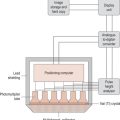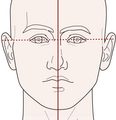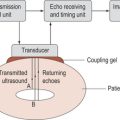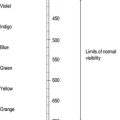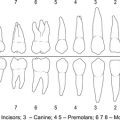W
Waldeyer’s ring a lymphoid tissue circle surrounding the pharynx. See also tonsils.
WAN (Wide Area Network) the connection of a group of computer networks.
WAP (Wireless Application Protocol) a standard to allow text messages from the web to be available to mobile phones.
washing in film processing is to remove fixer solution and the remaining soluble silver complex salts from the film surface.
water phantom a water tank containing a small ionization chamber; the radiation beam can enter the tank either horizontally or vertically. The signal is displayed on a television monitor and the image is analysed for radiotherapy treatment planning.
watt (W) derived SI unit (International System of Units) for electrical power, watts equal volts times amps (W=VI).
waveguide a series of chambers with small iris diaphragms between them and varying distance apart. The function is to control the velocity of the electron beam that passes through it. See also magnetron, klystron.
wavelength (λ) the distance travelled in one complete cycle, usually expressed in millimetres; it is dependent on the frequency and propagation of speed. The term can refer to electricity or ultrasound. See also propagation speed.
wave theory the theory of electromagnetic radiation which considers that the radiation is produced as a sinusoidal wave consisting of an electrical field with a magnetic field at right angles to it.
web server a computer which fetches or stores images or web pages and makes them available over the internet or intranet on request.
wedge a wedge-shape piece of metal used to attenuate the beam over part of the field during radiotherapy treatment.
wedge angle for a particular wedge is the angle that the 50% isodose line makes with the central axis of the X-ray beam. The angle defined at a specific depth of tissue in a patient, usually 10 cm.
wedged pair dose distribution when two beams of the same wedge angle are used to produce an ideal dose distribution when used with a hinge angle of (180–200) degrees.
wedge factor the increase in set monitor units required to the same dose at Dmax with a wedge as without the wedge present for the same field size.
weight force acting on a body due to gravity, unit newton.
weighted capitation the allocation of resource based on the number of people in an area but adjusted for the age profile or the relative economic and social conditions, e.g. areas with a high level of social deprivation would be allocated extra resource.
well counter a scintillation counter containing a sodium iodide crystal with a depression cut out of it, a bottle containing the sample is placed in the depression and the gamma emission from the sample is measured.
wetting agent an addition to the film emulsion to reduce the surface tension and allow the easy penetration of chemicals, an addition to developer to reduce the surface tension of the film.
Wharton’s jelly embryonic connective tissue contained in the umbilical cord.
wheezing a whistling or rasping breathing sound, occurs when air is forced through fluid. Associated with the bronchospasm of asthma and other conditions.
white matter white nerve tissue of the CNS, the myelinated fibres. See also grey matter.
white muscle a term used to describe muscle consisting mainly of fast-twitch fibres. It is white because there is very little myoglobin and a less abundant blood supply than in red muscle.
Wilcoxon test a statistical test used to compare two sets of results using a Wilcoxon test table and a normal distribution table. The results must be equal to or less than the reading on the tables to be significant. A non-parametric alternative to Student’s paired test.
Wilms’ tumour the commonest abdominal tumour of childhood, and one which usually affects the kidneys. Usually diagnosed during the preschool period. Prognosis is uncertain and depends on the stage of the tumour and child’s age at onset of diagnosis and treatment. See also nephroblastoma.
winchester disk a large-capacity hard disk, is housed in a hermetically sealed container, as any ingress of dust or dirt, no matter how microscopic, could possibly destroy very large amounts of data.
window the range of grey scale (or colour scale) values displayed in a digital image.
window centre the central point in a range of grey scale (or colour scale) values.
window level the centre of the window width, another term for window centre.
window mean the average range of pixel values in an image.
window width the range of displayed pixel values in a digital image.
WinZip a computer program that is used to compress computer files prior to storage or sending to another computer thus saving on storage space or transmission time.
wire diaphragms an additional set of wires attached to a simulator to accurately display the edges of the treatment area.
wisdom tooth lay term for the molar tooth placed eighth from the midline in the secondary dentition. The last teeth to erupt.
Wiskott–Aldrich syndrome an immunodeficiency disorder resulting in increased susceptibility to viral, bacterial and fungal infections.
work the product of the force acting on a body times the distance the body moves, unit joule.
WORM (Write Once Read Many) optical disks which are used once to receive data for archiving and can subsequently be read as often as is required.
wound healing there are four stages/phases in normal wound healing: haemostasis, inflammation, proliferation and maturation, which may take many months. Wound healing may be delayed by local factors, e.g. mechanical stress, inadequate blood supply, or by general factors that include: malnutrition, ageing, drugs such as corticosteroids, etc. Wound healing may be by first/primary intention in a clean wound with the edges in apposition. There is minimal scarring and deformity; second intention when the wound edges are not in apposition, the gap must be filled by granulation tissue before epithelialization can take place; or by third intention when a wound is left open until local factors such as infection have been treated before the wound edges are brought together.
wrap around (aliasing, fold-over) an artefact that occurs in magnetic resonance imaging due to the image-encoding process. It occurs when the field of view is smaller than the area being imaged.
wrist drop paralysis of the muscles which raise the wrist, caused by damage to the radial nerve.
write protect a method of protecting a computer file or disk to prevent the contents being altered or deleted.
WWW (World Wide Web) an information and resource centre for the internet.


